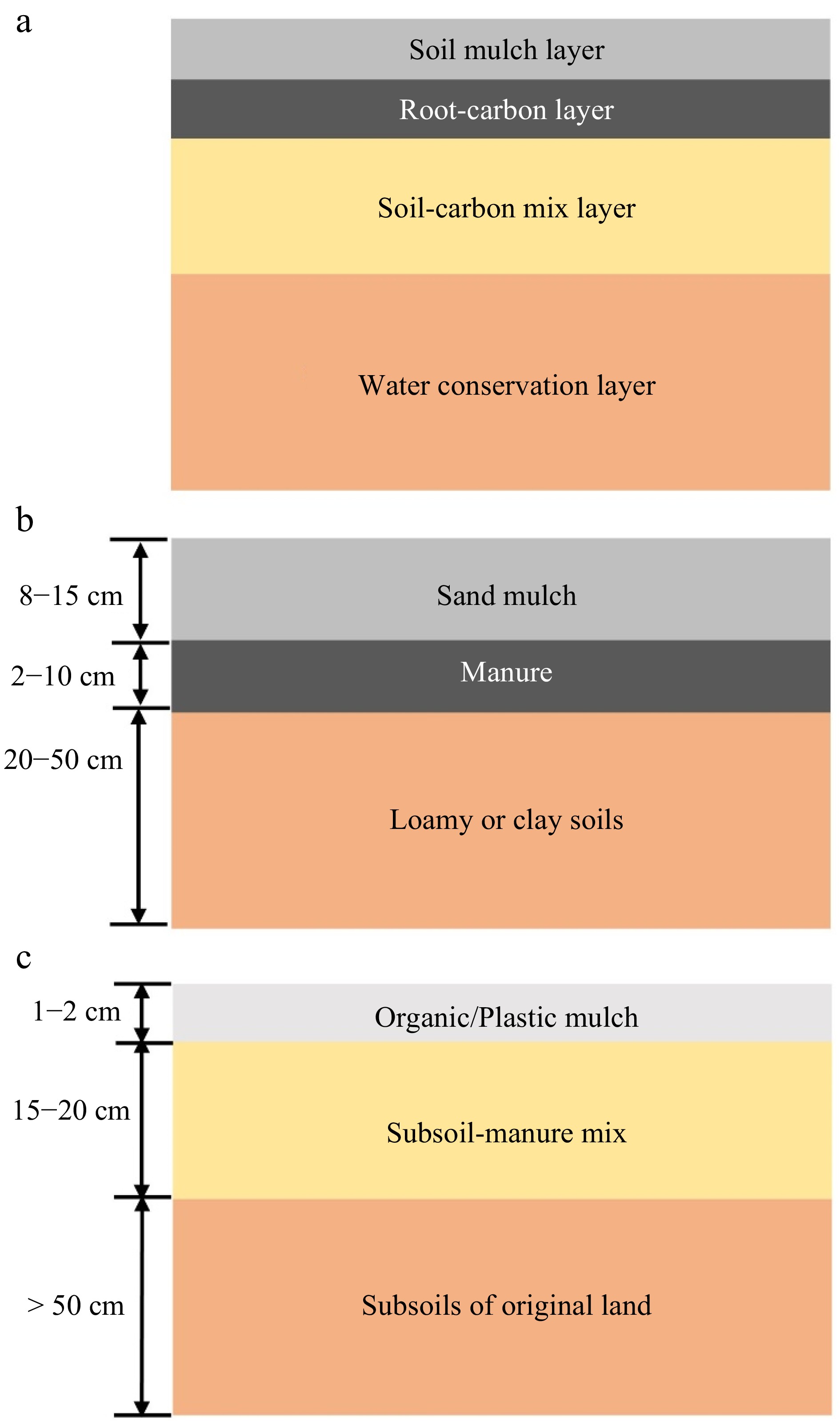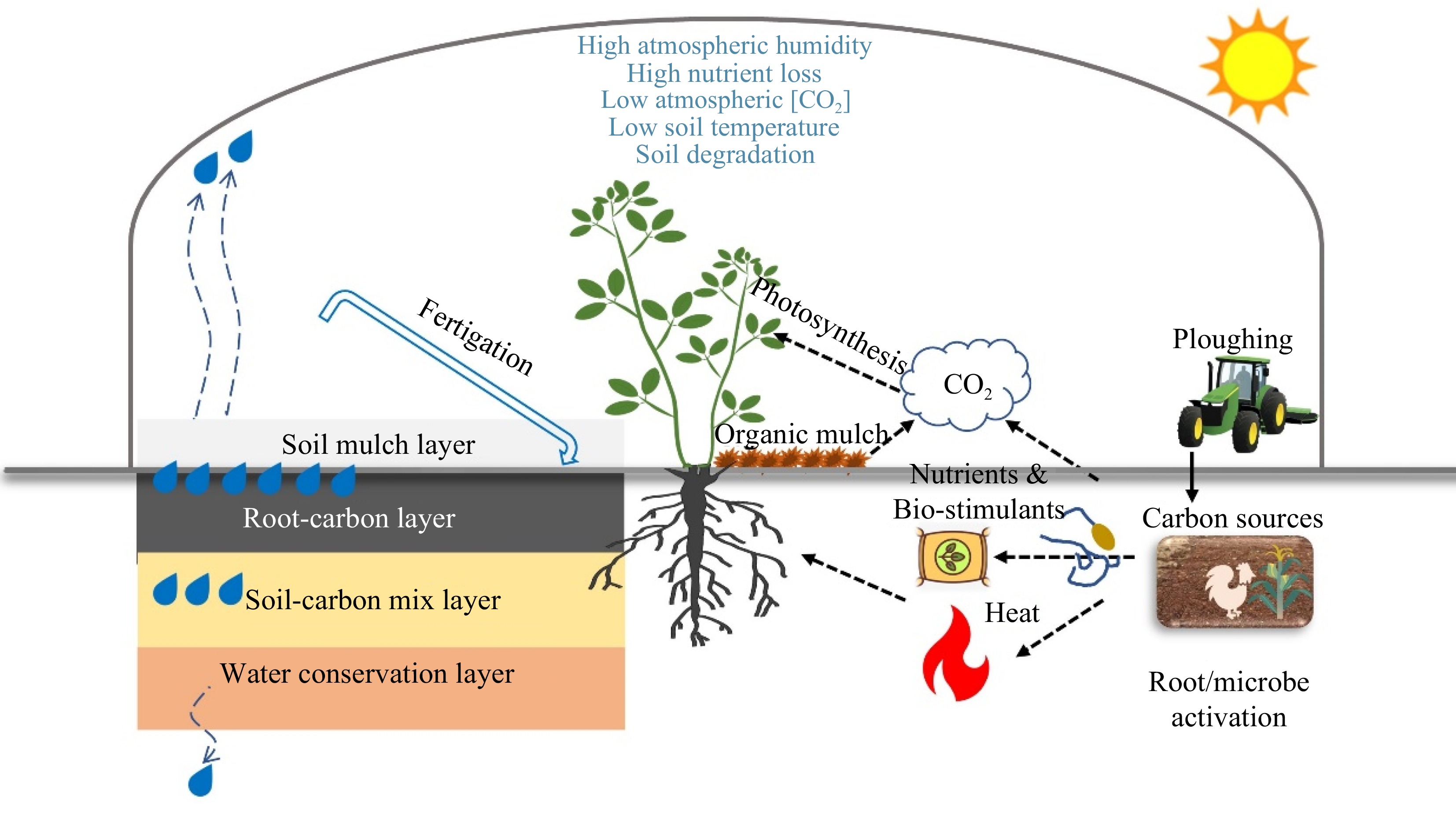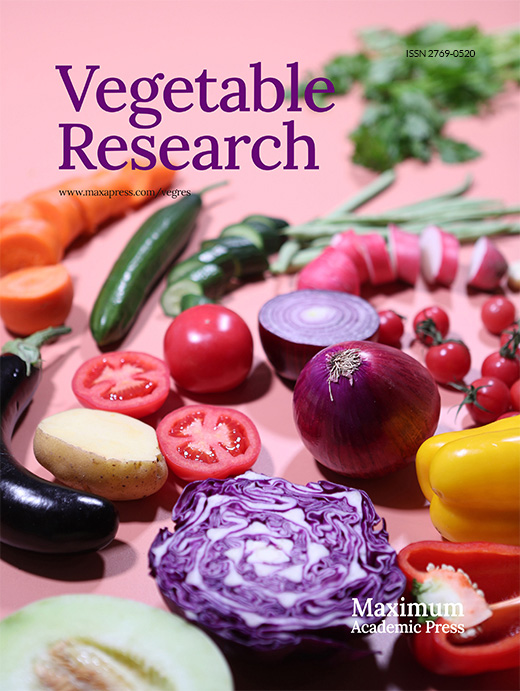-
Plastic greenhouses, including high tunnels and solar greenhouses, are specifically designed to safeguard horticultural crops from abiotic or biotic stresses such as low temperatures, high light intensity, and insects. These ensure the plants to thrive, enabling to produce fresh products throughout the year[1, 2]. The soils within plastic greenhouses possess distinct conditions and characteristics that differ substantially from open-field soils, which are called Anthrosols[3]. These differences arise from the unique microclimate and management practices associated with protected cultivation. It is estimated that plastic greenhouses cover a global area of 4.8 million hectares, mainly in Eastern Asia (such as China, South Korea, and Japan), Southern Europe (like Spain and Italy), Southern Asia (like India and Pakistan), and Northern Africa (like Egypt and Morocco)[4, 5].
Plastic-greenhouse soils are highly economically beneficial and thus intensively managed. However, the intensive use of agrochemicals, such as fertilizers and pesticides, within plastic greenhouses can deteriorate soil conditions and accelerate soil degradation, such as soil acidification and salinization, and threaten environments causing underground water pollution, and greater greenhouse gas emission, compared to open-field soils[6, 7]. The soil degradation can lead to severe yield and quality penalties for crops[1, 8, 9].
Horticultural production systems may opt for soilless substrates or hydroponic culture as alternatives to soils[10]. While these modern practices can precisely control the environment and result in high yield and quality crops[11−13], they are typically technology-dependent, energy-consuming, and costly, making them unaffordable for smallholders who own most of the plastic-greenhouse soils globally. Moreover, precise control results in low soil resilience to buffer the supply of water, nutrients, and growth conditions like pH, regardless of whether soilless substrates or hydroponic water are used, despite saving water and nutrients. Countries with numerous smallholders, such as Spain, Italy, China, India, and less developed African countries, must take advantage of the lower labor costs compared to the Netherlands, UK, and Japan to create jobs and provide a decent life to the smallholders. This can be the other reasons leading to high demands for plastic-greenhouse horticulture production of low to medium technology[4, 14]. In recent decades, organic farming systems are further advocated to produce organic-certified and environment-friendly foods in plastic-greenhouses[15−17]. The growers using substrate in Almeria has declined from 20% of surface area in approx. 2000 to less than 15% now. And, it is continuing to decline. Therefore, it is urgent to design and manage plastic-greenhouse soils for smallholders cost-effectively. However, information on the creation of plastic-greenhouse soil profile is lacking. Gaining a comprehensive understanding of the existing principles of soil design is crucial for attaining optimal conditions and promoting sustainable plastic greenhouse soil management.
-
Soils serve as a critical surface layer on Earth, acting as reservoirs for water, nutrients, air, and heat necessary for plant growth. Soils therefore can support human and animal well-being by facilitating element biogeochemical cycles, and food webs[18, 19]. Plastic-greenhouse soils differ from open-field soils due to intensive anthropogenic activities, such as multiple cropping, semi-closed plastic covers, excessive use of chemicals, and frequent irrigation[1, 5, 20]. Hence, plants grown in plastic-greenhouse soils are often subjected to greater water and nutrient loss, low atmospheric carbon dioxide concentration, low soil temperature, high atmospheric humidity, soil compaction, and soil degradation compared to open-field crops (Table 1).
Table 1. The constraints for plastic-greenhouse horticulture production, corresponding reasons and remediation measures from soil perspective.
Constraints Reasons for the constraints Remediation from soil perspective Ref. Low atmospheric [CO2] Partly sealed environment by plastic covers limits CO2 diffusion from atmosphere to greenhouses Application of organic or inorganic amendments to soils, accelerating their quick decomposition [47,48] High atmospheric humidity Plastics limit the diffusion of evaporated water, strengthened by frequent irrigation Organic or plastic mulch, and drip irrigation to allow low evaporation [37,49] Low soil temperature Off-season horticulture production, frequently in winter period Decreased soil-specific heat capacity, and heat production and preservation [22,50] Nutrient loss Heavy chemical and organic fertilizer input and frequent irrigation, facilitating leaching of $ {\text{NO}^-_3} $, and production of NOX and NH3 Limiting leaching or gaseous N loss by water conservation soil interlayer or less irrigation [5,51] Soil compaction Extensive mobility of machine and human Increasing organic fertilizer input, and frequent ploughing [52,53] Soil pollution, acidification, and salinization Heavy chemical input and residue leftover Addition of organic fertilizer, and decreasing the origin of residual toxins [26,54] As a result, plastic-greenhouse soils should fulfill certain requirements. They should provide sufficient water and nutrients for crop growth and oxygen for root and soil respiration as the open-field soils. In addition, different from open-field soils, they should store and buffer water and nutrients with minimal loss, considering the high input of fertilizers and frequent irrigation; they should supply extra carbon dioxide for enhanced plant photosynthesis in the partly sealed environment[21] and extra heat for root growth concerning low temperature in winter[22]; they should minimize soil evaporation to avoid high atmospheric humidity, achieving high transpiration for nutrient uptake, and reducing the risk of pathogen infection[23, 24].
-
Based on the requirements of plastic-greenhouse soils, the soil profile can be designed and consist of four soil layers: a mulch layer, a root-carbon layer, a soil-carbon mix layer, and a water conservation layer (Figs 1a & 2, Table 2). More specifically, the mulch layer isolates soils from the atmosphere, preventing soil evaporation for water conservation and humidity alleviation. Additionally, the mulch layer absorbs heat from solar radiation, warming the soil, and preventing soil salts from moving into the root-carbon layer from the buffer layer due to high porosity, thus reducing soil salinization[25]. The root-carbon layer is a thinner layer designed to receive carbon-containing compounds to produce nutrients and CO2 for plant production, to generate heat from microbial decomposition, and to remediate soil toxins resulting from high microbial enzyme activities[26], which facilitates root proliferation and nutrient uptake.

Figure 1.
Profile of plastic-greenhouse soils as (a) conceptual framework and two examples for horticulture production as sand mulching profile charactered by sand mulch in (b) Almería, Spain modified based a previous study[25], and as sunken profile charactered by digging to obtain subsoils of clay in (c) Shouguang county, China.

Figure 2.
Plastic-greenhouse soil profile that motivates carbon and nutrient cycling, and heat production, and saves nutrient and water for that can counteract the environmental constraints of high atmospheric humidity, high water and nutrient loss, low atmospheric CO2, low soil temperature, soil compaction, and soil degradation. Some of the symbols were adopted from IAN/UMCES Symbol and Image Libraries.
Table 2. The profiles of plastic-greenhouse soil, their primary function and the practices to establish the cost-effective soil layer.
Soil profile Primary function Practices Soil mulch layer Evaporation inhibition Rice husk mulching Root-carbon layer Root and microbe activation Manure or compost application Soil-carbon mix layer Increase soil resilience Biochar or peat input Water conservation layer Water and nutrient preservation Deep placement of
clay soilsThe soil-carbon mix layer combines original soil with carbon-containing compounds through tillage. This layer serves as a buffer layer to store extra nutrients and water for root growth, and to buffer or decompose toxic metabolites resulting from soil-plant interaction, such as microbial metabolites, root exudates or plant residues[27]. The bottom water conservation layer using easily-compacted materials is necessary to preserve water and nutrient within the above layers for root growth and plant production, and thus minimize water and nutrient leaching out to underground water body. The depth of these four layers depends on the specific requirements of a local soil and climate.
-
The high economic benefit of plastic greenhouse production motivates farmers to invest and construct a cost-effective system including an advisable soil profile for plant growth when the greenhouses are newly built or renewed (Fig. 2). Local clay or loamy soil can be used as a cheap material to form a water conservation layer by either digging to obtain the clay subsoils in the illuvial horizon or transporting clay soils from other places. Alternatively, natural clay minerals, sewage sludge, and coal cinders can be used[28]. The carbon sources for soil-carbon, root-carbon, and organic mulch layers are mostly organic, such as straws, green manures, animal manure, and compost[29, 30]. Inorganic carbon sources, such as lime, are less likely to be used, except in cases where soils are acidified. If carbon sources, such as lime, green manures, or animal manures, activate extensive soil chemical or bio-chemical reactions, and thus the accumulation of toxic compounds such as flavonoids or organic acids, it is recommended that plant transplantation or seeding to be conducted several weeks later after carbon application to avoid root growth inhibition[31, 32].
The application of high rates of corn stalk compost and manure from the introduction of either chicken or earthworms into plastic-greenhouse soils can boost the soil organic matter to ca. 18%, which has dramatically improved the production, yield, and quality of tomato plants due to the supply of CO2 for photosynthesis that can reach 1,000 µmol·mol−1 [33], and a 2 °C increment of soil temperature[34, 35]. However, the reapplication should be conducted once or twice a year when soil organic matter is below 2.7% to maintain high carbon availability in the entire greenhouse, and thus improved yield and quality of horticultural production[35]. The root-carbon and mulch layers are readily combined with the soil-carbon layer to form the soil-carbon layer for the crops of next season, using a rotary tiller after crop harvest, and then the root-carbon and mulch layer can be reconstructed layer by layer.
-
The application of the current conceptual framework depends on various factors, such as plant species, soil properties, and local climates and resources. For instance, the depth of soil-carbon mix layer should match the root depth of the crops, and thus should be deeper when designed for deep-root trees such as cherries and grape compared to vegetable plants. The water table in some areas, such as Southern China, is high, which may limit the construction of a deep plastic-greenhouse soil profile. Here, one example of sand mulching profile in Almería, Spain was summarized whilst another example of sunken profile in Shouguang county, China was proposed. Almería and Shouguang are the two typical cities on the global vegetable belt (close to 37° parallel north) well-known for plastic-greenhouse horticulture production[36].
-
Sand mulching soil profile, also known as enarenado, in Almería, is the world's most well-known plastic-greenhouse soil profile[37] (Fig. 1b). This technique was first introduced in 1955 by local farmers, using a water conservation layer of loamy or clay soils from areas outside Almería, as the local soils were frequently sandy. This water conservation layer was primarily constructed to facilitate plant growth by reserving water and nutrient, but unexpectedly limiting water and nutrient leaching to an extent. This layer was followed by a root-carbon layer of manure, such as sheep manure from farms elsewhere, and a soil mulch layer of sand from the Mediterranean Sea beach[25]. This soil profile fully utilized agricultural waste, sand, and loamy/clay soils near Almería and was much more cost-effective than soilless culture in the past several decades.
However, the materials become increasingly expensive due to the availability of loamy/clay soils and restriction of taking beach sand. The replacement of sand by gravel from a quarry occurs currently. Sand mulching accounts for approximately 90% of the land used for plastic-greenhouse vegetable cultivation across Almería[25]. In addition, the manure layer can be banded close to the plant roots instead of across the entire plastic greenhouse in the following season. This is called banding technology, which helps savings on manure and reconstruction of manure (root-carbon) layer. The use of sand mulching soil profile has widely accepted by smallholders in Southeastern Spain as a low to medium technology, outperforming the production from modern glasshouses in the Netherlands and from substrate culture due to its high net income, less energy consumption, and less dependence on modern facilities despite a relatively low yield[38, 39].
-
The solar greenhouse with a north wall inside to support its roof was developed in the 1950's and has since been continuously upgraded. Its use has reached 810 thousand ha in Northern China[12]. However, the soil profiles have yet been fully understood to our knowledge. Based on the authors' survey in Shouguang county and the concept of plastic-greenhouse soil profile, we have proposed one soil profile called 'Sunken soil profile', as shown in Fig. 1c. More specifically, local farmers remove the topsoil of approximately 50 cm from the original farmland used for wheat or corn production. This practice provides materials for the construction of north walls supporting the entire solar greenhouse, and the wall is thought to preserve heat within the plastic greenhouses[20]. Unexpectedly, this practice builds a water conservation layer as the local subsoils contain greater clay content, decreasing the loss of water and nutrients from the rooting zone[40]. The root-carbon layer is a mix of the original subsoil and manure, such as poultry litter or cow manure. This layer is readily formed by broadcasting manure on the top of subsoil layer and then rotary tillage. The surface layer is then covered by organic mulch, frequently rice husk, which alleviates plant diseases from soil pathogens due to decreased atmospheric humidity, according to the survey from local farmers.
Similar to Almería's sand mulching profile, the plastic-greenhouse soil cultivation is more profitable and suitable for smallholders than modern soilless cultures (Table 3). In addition, this sunken profile substantially decreases the ratios of leaching to total application of the nutrients (including nitrate) in the topsoil of approximately 20 cm compared to open-field soils[1, 41, 42].
Table 3. The comparison of the costs of tomato production in plastic greenhouses between sunken profile and soilless culture (CNY ha−1) in the Shouguang county, Northern China in 2022.
Items Sunken profile Soilless culture Total costs 379,500 657,000 Seedlings 45,000 48,000 Water and fertilizers 108,000 165,000 Workforce 180,000 285,000 Substrate 0 90,000 Others 46,500 117,000 Income 634,500 877,500 Tomato yield (t·ha−1) 211.5 292.5 Net profits 255,000 220,500 The price of tomato was CNY3,000 t−1. The others include machine and land rent, fertigation energy consumption, and pesticide. The data were based on a survey of the local smallholder farmers. In addition, current soil profile has been modified by the use of plastic film rather than organic mulch when organic material being not available or expensive, or without the removal of topsoil using topsoil to mix with manure as root-carbon layer directly. The modifications were frequently observed in Southern China where the winter season was relatively warm compared to Northern China.
-
The development of plastic-greenhouse soil profiles has seldom been given its importance because it is commonly believed that the transformation of open-field soils takes longer than decades to influence soil profile. However, plastic-greenhouse soils typically receive much greater organic input, reaching more than 300 t·ha−1, averaging 73 t·ha−1 across China (authors' unpublished data), compared to less than 10 t·ha−1 on average received by open-field soils[9, 43]. The high temperature caused by covers further facilitates root growth and microbial activity in both the root-carbon layer and the soil-carbon mix layer, thereby accelerating soil development, such as organic carbon decomposition and root-microbe-driven soil weathering. For instance, the addition of straws and manures has been shown to increase soil microbial necromass carbon to a great extent compared to plant-deprived carbon in the plastic-greenhouse, and thus facilitate soil organic carbon sequestration[44]. Moreover, continuous irrigation can be expected to leach soluble organic or inorganic compounds, such as fulvic acids and dissolved organic N, into the subsoils[45]. As the bottom of soil-carbon mix layer is compacted and rarely disturbed via tillage, a layer of clay-humic complexes is likely to develop.
In addition to organic compounds, phosphorus accumulates excessively in plastic-greenhouse soils in either organic or inorganic form due to its low mobility[46]. Hence, phosphorus will accumulate within soils above the water conservation layer. Moreover, the saline crust can be expected to be formed when soils receive excessive residual salts and are managed for long periods, causing soluble salt to move up to the surface layer via capillary rise[1].
-
This study provides a comprehensive understanding of the plastic-greenhouse soil profile of low to medium technology. The soil profile was proposed to have four layers: a soil-mulch layer to limit evaporation, a root-carbon layer to generate nutrient, CO2 and heat, a soil-carbon mix layer as a buffer layer for supply of water and nutrients, and soil degradation, and a water conservation layer to conserve water and nutrients. Sand mulching profile in Almería and sunken profile in Shouguang are two typical examples that reflect the principles of the profile design for plastic-greenhouse soils. Though not precisely managed, the formulation of current plastic-greenhouse soil profiles is affordable and more sustainable for smallholder farmers.
The practices of plastic-greenhouse soil management need modification according to crop type, and specific or local conditions. Research should focus on how the plastic-greenhouse soil profiles can be managed sustainably in the long run, and taking advantage of enhanced carbon availability and microbial activity to facilitate plant production and improve soil health. More importantly, removing toxins or residual salts from the organic and inorganic inputs should be conducted despite the difficulty involved for numerous smallholder farmers.
-
The authors confirm contribution to the paper as follows: study conception and design: Dong J; writing the first version of the manuscript: Dong J; manuscript revision: Gruda N, Tang C, Yang S, Cai Z, Fan Y. All authors reviewed the results and approved the final version of the manuscript.
-
The datasets generated during and/or analyzed during the current study are available from the corresponding author on reasonable request.
Jinlong Dong appreciates the funding support provided by the National Natural Science Foundation of China (42207357) and the Natural Science Foundation of Jiangsu Province (BK20211399).
-
The authors declare that they have no conflict of interest.
- Copyright: © 2024 by the author(s). Published by Maximum Academic Press, Fayetteville, GA. This article is an open access article distributed under Creative Commons Attribution License (CC BY 4.0), visit https://creativecommons.org/licenses/by/4.0/.
-
About this article
Cite this article
Dong J, Gruda N, Tang C, Yang S, Cai Z, et al. 2024. How to design cost-effective soil profiles in plastic greenhouses? Vegetable Research 4: e011 doi: 10.48130/vegres-0024-0010
How to design cost-effective soil profiles in plastic greenhouses?
- Received: 11 October 2023
- Revised: 28 February 2024
- Accepted: 08 March 2024
- Published online: 02 April 2024
Abstract: Plastic-greenhouse soils, spanning approximately 4.8 million hectares worldwide, are predominantly cultivated by smallholder farmers for horticultural production. These soils contribute greatly to the production of vegetables, herbs, and fruits, and thus to a healthy diet and high farmers' income. Nevertheless, the current challenge is a comprehensive understanding and design of cost-effective profiles for plastic-greenhouse soils of low to medium technology. Here, we devised a novel conceptual framework of a plastic-greenhouse soil profile, considering the environmental limitations imposed by the plastic covering. The profile comprises four distinct layers: a mulch layer to reduce evaporation, a root-carbon layer to facilitate nutrient, CO2 and heat generation, a soil-carbon mix layer for effective soil buffering, and a water conservation layer to store water and nutrients. Two typical examples of this concept were summarized, the sand mulching profile in Almería, Spain and the sunken profile in Shouguang, China. This soil profile design is affordable and cost-effective for smallholder farmers to produce horticulture product sustainably, therefore, it is worth being applied worldwide. Future studies should adopt the current concept but modify it based on the local soil profile and available resources. More importantly, controlling organic input and thus microbial functions are required to facilitate either plant or soil health.
-
Key words:
- High tunnel soil /
- Microbial community /
- Plastic shed /
- Soil layers /
- Soil profile /
- Organic amendments












